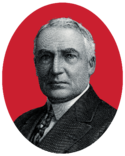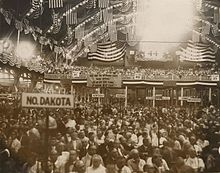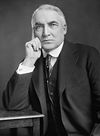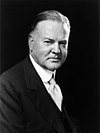
Calvin Coolidge was an American attorney and politician who served as the 30th president of the United States from 1923 to 1929.

Warren Gamaliel Harding was the 29th president of the United States, serving from 1921 until his death in 1923. A member of the Republican Party, he was one of the most popular sitting U.S. presidents. After his death, a number of scandals were exposed, including Teapot Dome, as well as an extramarital affair with Nan Britton, which diminished his reputation.
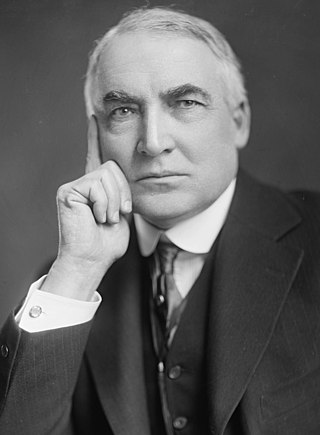
The 1920 United States presidential election was the 34th quadrennial presidential election, held on Tuesday, November 2, 1920. In the first election held after the end of the World War and the first election after the ratification of the Nineteenth Amendment, Republican Senator Warren G. Harding of Ohio defeated Democratic Governor James M. Cox of Ohio. Both major-party vice-presidential nominees would later succeed to the presidency: Calvin Coolidge (Republican) upon Harding's death in 1923 and Franklin D. Roosevelt (Democratic) after defeating Republican President Herbert Hoover in 1932. This was one of only six presidential elections where both major candidates had the same home state.

The 1924 United States presidential election was the 35th quadrennial presidential election, held on Tuesday, November 4, 1924. In a three-way contest, incumbent Republican President Calvin Coolidge won election to a full term. Coolidge was the second vice president to ascend to the presidency and then win a full term.

Harry Micajah Daugherty was an American politician. A key Republican political insider from Ohio, he is best remembered for his service as Attorney General of the United States under presidents Warren G. Harding and Calvin Coolidge, as well as for his involvement in the Teapot Dome scandal during Harding's presidency.

Irvine Luther Lenroot was an American attorney, jurist, and Republican Party politician from Wisconsin. He served as Speaker of the Wisconsin State Assembly from 1903 to 1907 and represented the state in the United States Congress from 1909 to 1927, first in the United States House of Representatives until 1918, and then in the United States Senate. After he lost the Republican nomination in 1926, Herbert Hoover nominated him to the United States Court of Customs and Patent Appeals.
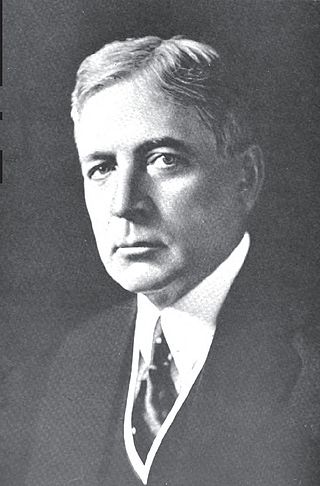
Frank Orren Lowden was an American Republican Party politician who served as the 25th Governor of Illinois and as a United States Representative from Illinois. He was also a candidate for the Republican presidential nominations in 1920 and 1928.

The 1908 Republican National Convention was held in Chicago Coliseum, Chicago, Illinois on June 16 to June 19, 1908. It convened to nominate successors to President Theodore Roosevelt and Vice President Charles W. Fairbanks.

The 1928 Republican National Convention was held at Convention Hall in Kansas City, Missouri, from June 12 to June 15, 1928.

The 1924 Republican National Convention was held in Cleveland, Ohio, at the Public Auditorium, from June 10 to 12.

The 1856 Republican National Convention was a presidential nominating convention that met from June 17 to June 19, 1856 at Musical Fund Hall at 808 Locust Street in Philadelphia, Pennsylvania. It was the first national nominating convention of the Republican Party, founded two years earlier in 1854. It was held to nominate the party's candidates for president and vice president in the 1856 election. The convention selected former John C. Frémont, a United States Senator from California, for president, and former Senator William L. Dayton of New Jersey for vice president. The convention also appointed members of the newly established Republican National Committee.

The 1960 Republican National Convention was held in Chicago, Illinois, from July 25 to July 28, 1960, at the International Amphitheatre. It was the 14th and most recent time overall that Chicago hosted the Republican National Convention, more times than any other city.

The 1932 Republican National Convention was held at Chicago Stadium in Chicago, Illinois, from June 14 to June 16, 1932. It nominated President Herbert Hoover and Vice President Charles Curtis for reelection.
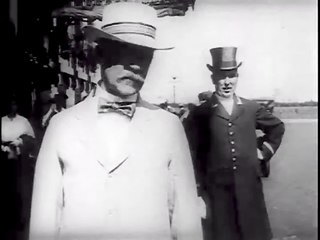
The 1916 Republican National Convention was held in Chicago from June 7 to June 10. A major goal of the party's bosses at the convention was to heal the bitter split within the party that had occurred in the 1912 presidential campaign. In that year, Theodore Roosevelt bolted the GOP and formed his own political party, the Progressive Party, which contained most of the GOP's liberals. William Howard Taft, the incumbent president, won the nomination of the regular Republican Party. This split in the GOP ranks divided the Republican vote and led to the election of Democrat Woodrow Wilson.

Wallace McCamant was an American jurist in Oregon. A Pennsylvania native, he served as the 46th justice of the Oregon Supreme Court from 1917 to 1918. Later he served briefly as a United States circuit judge of the United States Court of Appeals for the Ninth Circuit. As a delegate to the Republican National Convention in 1920, McCamant surprised the GOP leadership by placing the name of Calvin Coolidge into nomination for Vice-President. Coolidge would become the 30th President of the United States upon the death of President Harding in 1923.

Electoral history of William Edgar Borah, United States Senator from Idaho (1907–1940)

The 1920 United States elections was held on November 2. In the aftermath of World War I, the Republican Party re-established the dominant position it lost in the 1910 and 1912 elections. This was the first election after the ratification of the 19th Amendment, which granted women the constitutional right to vote.
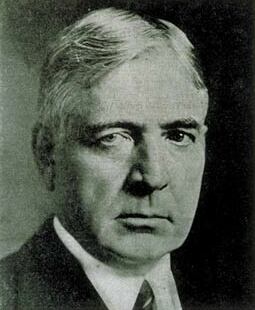
From March 9 to June 5, 1920, voters of the Republican Party elected delegates to the 1920 Republican National Convention for the purposing of choosing the party's nominee for president in the 1920 election.

The presidential transition of Warren G. Harding began when he won the United States 1920 United States presidential election, becoming the president-elect, and ended when Harding was inaugurated at noon EST on March 4, 1921.
